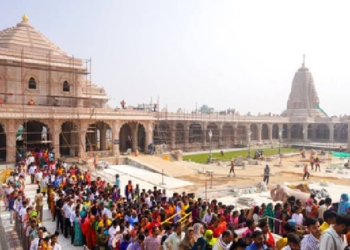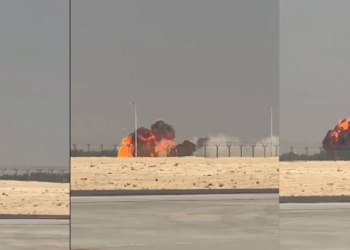New Delhi: Twenty-two people have been arrested for allegedly using pepper spray against police personnel after officers attempted to disperse a group blocking the road at India Gate’s C-Hexagon during a protest against rising pollution levels in Delhi-NCR, officials confirmed on Monday.
The demonstrators, who had gathered on Sunday evening to raise slogans over deteriorating air quality in the national Capital, clashed with the police when the situation escalated, and some protesters allegedly used pepper spray.
Two FIRs have been filed in connection with the incident, with Delhi Police invoking multiple relevant Sections. According to officials, an FIR was registered that led to the arrest of around 22 individuals for allegedly using pepper spray on police personnel, obstructing official duties and blocking a public road.
At Kartavya Path Police Station, six male protesters were detained under BNS Sections 74, 79, 115(2), 132, 221, 223 and 61(2). A second FIR was lodged at Sansad Marg Police Station, where more protesters were taken into custody under BNS Sections 223A, 132, 221, 121A, 126(2) and 3(5).
According to officials, several protesters had moved into the C-hexagon area and attempted to cross barricades placed to regulate movement.
Police personnel explained to them that ambulances and medical teams were stuck behind the blockade and needed urgent passage, but the protesters allegedly became “agitated”.
Sensing that the situation could escalate into a confrontation, officers advised the demonstrators to step back. However, officials said the protesters ignored the instructions, broke through the barricades, moved onto the road and sat down, forcing the police to intervene.
The group was removed from the C-hexagon to prevent further disruption to traffic in the busy zone.
This incident came just days after several people were detained on November 9 at India Gate during a “clean air protest”, where participants demanded immediate government intervention and stricter policies to address what they described as an “air emergency” in the national Capital.
The protests have been taking place as visibility dropped across several parts of the city, as the toxic haze thickened, prompting renewed health warnings from authorities.
Neighbouring NCR cities are also struggling with deteriorating air quality. Faridabad reported an AQI of 358, Gurugram 370, Ghaziabad 355, Greater Noida 342, and Noida 372.
While most Delhi localities are hovering between AQI 300 and 400, several pockets have already breached the 400 mark, slipping into the ‘severe’ category. Officials say conditions may worsen if wind speeds remain low.
Amid rising pollution levels, the Commission for Air Quality Management for NCR and adjoining areas on Saturday revised the Graded Response Action Plan.
In a press release, the CAQM said measures earlier reserved for the ‘severe’ category under GRAP Stage IV would now be enforced at Stage III.
The steps include ensuring an uninterrupted power supply to reduce diesel generator use, deploying additional personnel at traffic congestion hotspots, issuing pollution alerts across media platforms, and expanding CNG and electric public transport fleets with increased service frequency, along with differential fares to promote off-peak travel.
Several measures earlier placed under Stage III for the ‘very poor’ category have now been moved to Stage II. These include staggered working hours for government offices in Delhi, Gurugram, Faridabad, Ghaziabad and Gautam Buddh Nagar.
The Centre may also consider staggered timings for its offices in the region.
Restrictions previously meant for Stage IV during severe AQI, such as allowing public, municipal, and private offices to function with only 50 per cent staff and requiring the remaining employees to work from home, will now be applicable at Stage III.
Meanwhile, the Delhi government has directed private offices to operate with 50 per cent on-site staff and allow the rest to work from home as a precautionary measure, as the Capital continues to grapple with deteriorating air quality.
(IANS)













